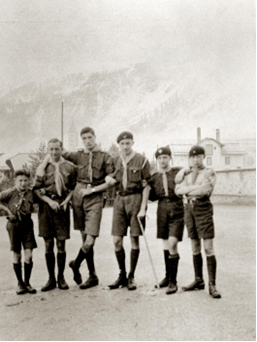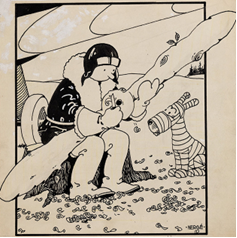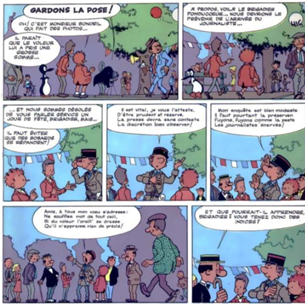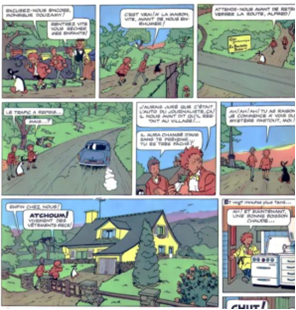By Julia Adams, Hannah Mackey, and Nala Washington
History of the Comic
The Adventures of Tintin is a world famous comic series, created in 1929 by the Belgian cartoonist Hergé whose real name was Georges Remi. The series is composed of 24 albums, from the first album being Tintin in the Land of the Soviets which is what we read for this project. As we were exploring Tintin, we wanted to give some historical perspective on how he came about.
The creator of the character Tintin is Georges Remi who was born in Etterbeek, Belgium on May 22, 1907. He began his studies in 1920 at the Collège Saint Boniface in Brussels. Shortly after in 1921, he joined the scout troop at his high school where he received the nickname “Curious Fox.” His first drawings appeared in Jamais Assez, his school scouting magazine at the time. Starting in 1923, he appeared in the Le Boy-Scout Belge, the monthly magazine of the Belgian Boy Scouts. After leaving school, Remi was hired by a newspaper called Le Vingtième Siècle as an employee in the subscription department. He began signing his drawings with the name “Hergé,” which was reversing his initials “R.G” (Hergé).
In 1926, Hergé created the character Totor who served as a precursor to Tintin. After serving in the military, Hergé returned to Brussels and was named the chief editor of the newspaper Le Petit Vingtième where the first issue was published on November 1, 1928 (Hergé). In 1929, Tintin and Snowy were born on January 10 in the Le Petit Vingtième. Tintin, a young investigative reporter who stars in the series and his fox terrier, Snowy who travels the world together in the service of truth and justice (Farshore). The first Tintin book was then published in 1930: Tintin the Reporter, in the Land of The Soviets. In 1934, Casterman Publishing House, which is based in Tournai, Belgium became the publisher of The Adventures of Tintin. Besides Tintin, Hergé went on to create a new cast of heroes for the French Weekly Coeurs Vaillants. Five books were published with his newer characters: Jo, Zette, and Jocko. Not too long after Hergé’s success, on May 10, 1940, Belgium was invaded by German troops. The newspapers Le Petit Vingtième and Le Vingtième Siècle both disappeared as a result. In the midst of another Tintin adventure, Tintin in the Land of Black Gold, was suspended for eight years. Hergé began another comic, The Crab with the Golden Claws, which he published in Le Soir, one of the only newspapers authorized during the German occupation at the time (Hergé).
Between 1942 and 1945, Casterman Publishing House planned to publish standardized books that contained 64 full pages of color and asked Hergé to start adapting previous Tintin episodes to fit these guidelines which he obliged. In the midst of this, Belgium became liberated from the Germans which ended the publication of The Adventures of Tintin in the newspaper Le Soir. Hergé was criticized for publishing in a newspaper controlled by German occupation; some say that Hergé collaborated with the newspaper and the idea of it being controlled by the Germans who were in support of the Nazis (Hergé). Throughout these years, others viewed the first few Tintin stories as prejudiced and racist which Hergé later tried to redo in less offensive tales, doing research along the way (Ray). In 1936, The Blue Lotus when Tintin traveled to China, Hergé also traveled to China in an attempt to accurately portray locales and characters. He met Chang Chong-Chen who became his friend and inspired this Tintin issue (Ray).
On September 26, 1946, the first issue of Tintin magazine was published. It became a weekly publication created for younger audiences by Raymond Leblanc, a fighter in the French Resistance. Between 1946 and 1955, Tintin became even more successful and popular. Tintin began to become of interest to advertisers as Hergé developed a collection of color prints in which Tintin played a spokesman for different fields. By 1960, Tintin went to the big screen. Belgian actor Jean-Pierre Talbot played him in the movie Tintin and the Mystery of the Golden Fleece. Talbot would reappear in 1964 in another movie adaptation, Tintin and the Blue Oranges. By 1973, Casterman decided to publish the first volume of Archives Hergé which included the story of Tintin in the Land of the Soviets that had not been available for almost 40 years until then (Hergé). By 1976, Tintin had a full length documentary which featured Hergé as a dedication to him. On September 29, 1976, a bronze statue of Tintin and his sidekick Snowy was inaugurated in Brussels.
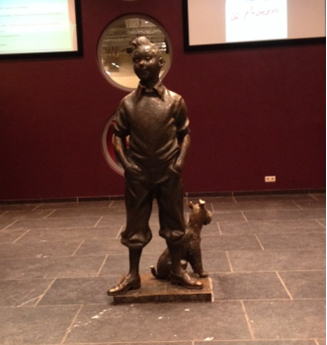
In 1977, American pop art artist Andy Warhol, created a series of four portraits in honor of Hergé and to celebrate Tintin’s fifty years. Tintin had quite an impact up until Hergé’s death on March 3, 1983. Upon his death, the 24th album in the Tintin series had been roughly sketched. The unfinished volume, Tintin and Alph-Art, was still published along with the other 23: Tintin in the Land of the Soviets, Tintin in America, Tintin: Cigars of the Pharaoh, Tintin: The Blue Lotus, Tintin: The Broken Ear, Tintin: The Black Island (the first Tintin comic that translated to English), Tintin: King Ottakar’s Sceptre, Tintin: The Crab with the Golden Claws, Tintin: The Shooting Star, Tintin: The Secret of the Unicorn, Tintin: Red Rackham’s Treasure, Tintin: The Seven Crystal Balls, Tintin: Prisoners of the Sun, Tintin: Land of Black Gold, Tintin: Destination Moon, Tintin: Explorers of the Moon, Tintin: The Calculus Affair, Tintin: The Red Sea Sharks, Tintin in Tibet, Tintin: The Castafiore Emerald, Tintin: Flight 714 to Sydney, and The Adventures of Tintin and the Picaros (Farshore).
Synopsis and Art Analysis
The Adventures of Tintin in the Land of the Soviets was initially created as satire belittling and criticizing the Soviets and the Joint State Police Directorate (OGPU), who were used to silence people during the 1920s and beyond. As Hergé was a Catholic and conservative, and worked for the Belgian conservative Catholic newspaper, Le Vingtième Siècle (The Twentieth Century), he specifically illustrated Tintin to further their ideals, especially to the youth. Hergé published The Adventures of Tintin in the children’s supplement of the newspaper, Le Petit Vingtième (The Little Twentieth). Due to the politicized nature of the newspaper and the anti-communist rhetoric spreading throughout Europe, TTintin in the Land of the Soviets was not a surprise. In fact, it exploded in popularity within and outside of Belgium. The comic filled the following decades with immense demands for reprints of the blonde hero and his cunning dog.
Hergé did not know firsthand what Russia was like, nor had he traveled there before writing Tintin in the Land of the Soviets. As mentioned in the foreword by translators Leslie Lonsdale-Cooper and Michael Turner in the Library of Congress reprint, Hergé had “not been to Russia, but had read a book published the year before, Moscou sans voiles: Neuf ans de travail au pays des Soviets by Joseph Douillet, a former Belgian consul in Rostov-on-Don” (Lonsdale -Cooper and Turner). Douillet’s work depicts the many falsehoods the Soviets propagated to the rest of the world, including how they faked the sound of bustling factories in empty warehouses to show how industrial Russia had become because of the Soviet Union (Douillet). Hergé includes this image in Tintin in the Land of the Soviets, as well as illustrating other claims made by Douillet in his work. The comic is in fact a caricature of Soviets, Russians, and the OGPU, and teases the lengths Soviets went to ensure the truth about their abuse of power, and abuse of communism and Marxism as political doctrines, did not get revealed to the rest of the world. Hergé found interest in this idea, which is also stated by Lonsdale-Cooper and Turner in the foreword of the first volume, and wanted to expound on it in Tintin’s adventure.
Hergé wrote Tintin’s character as if he was a real investigative reporter for Le Petit Vingtième. In the first panel, Hergé tells the reader that, “At ‘Le Petit XXe’ we are always eager to satisfy our readers and keep them up to date on foreign affairs. We have therefore sent Tintin, one of our top reporters, to Soviet Russia” (Hergé). The illustrated “photographs” detail Tintin’s fictional adventure to Moscow as a journalist and unofficial spy. The story is about Tintin’s travels in Russia, in which he hopes to document the truth about communism and the OGPU surveilling the country. First, a member of the OGPU bombs the train car Tintin is riding in and he somehow survives. After being questioned in Berlin for his involvement, they put him in solitary confinement. What follows is the first instance of Tintin’s absurd strength, adding to the unrealistic, cartoony aspect of it all. He single-handedly fights off the officer in solitary confinement and escapes with no injuries, the officer’s uniform on and Snowy close behind him. Following this, Tintin and Snowy get into more violent situations but manage to survive each encounter thanks to Tintin’s quick-thinking and craftsmanship, emphasizing the youthful, timeless nature of the comic. With Tintin’s expert reporting, he finds that the Russian factories are fake, leading to Russians without jobs and a poor economy, and that the grain is being sent away as propaganda which is starving the people. He also witnesses the current Soviets threatening people to vote for them to gain more political power. Before he gets executed by firing squad in the second half of the comic, Tintin fakes his death, is later captured again and locked in a dungeon, where Snowy saves him. They both return to Belgium, heroes and satisfied with their eventful time in Russia.
Despite the art of Tintin being relatively cartoonish, slapstick without consequence, Hergé convinced young readers that Tintin was real and had witnessed everything in Russia firsthand. Hergé takes primary inspiration from French cartoonist Alain Saint-Ogan, who illustrated Zig et Puce (Lofficier). Hergé’s youthful protagonist and the cartoonish antics across different countries mimic Saint-Ogan’s characters, two teenage boys getting up to mischief and embarking on their own adventures. The art, unlike Hergé’s, is colorful and more elaborate in a variety of ways, like in giving the characters full eyes instead of single dots, buttons, ties, and more intricate details on clothing, and full backgrounds instead of large backdrops of white space or outlines of buildings.
Each black and white page in The Adventures of Tintin in the Land of the Soviets contains six panels or fewer. Panels are either rectangular, taking up the space of two square panels which would usually be next to one another, or a mixture of square and rectangular panels depending on the action taking place. Most panels contain action-to-action progressions and, less frequently, subject-to-subject progressions.
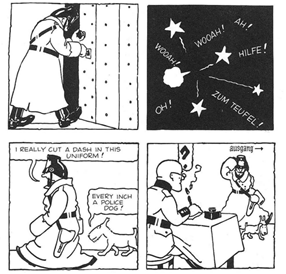
(Source: Hergé)
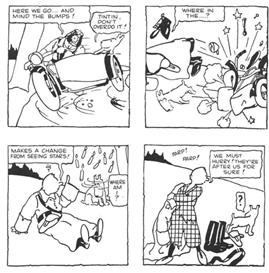
(Source: Hergé)
Hergé uses few scene-to-scene transitions in this volume of Tintin, as the reader stays relatively present with the comic’s protagonist. Tintin and Snowy act as narrators throughout the text, speaking to the audience and to each other (although Tintin and other humans never actually hear Snowy speak) about where they are going, what they are thinking, and what comes next. It makes sense that Tintin describes most of what happens to keep the comic accessible to children and teens alike. Text rarely overwhelms speech bubbles, and the simple line art and character designs allow for iconography to develop and solidify into the mind of the reader. The simple art also allows for easier depictions of a basic range of emotions like happiness, sadness, and anger, and to get the action across efficiently.
Tintin’s Significance
Over the course of its publication, The Adventures of Tintin has made significant impact globally, but especially on the culture of its home country of Belgium. However, we were curious on how the comics came to have such a deep effect on Belgian citizens and how Tintin became a national icon through popular culture. On the surface, Tintin’s early beginnings and the subsequent publications over many years can partially explain the character’s importance because “‘the longer the history of the icon, the richer the layering of indexical and symbolic significances organically attached to it’” (Desbiens-Brassard 28-29). Alone, though, this history would not have been enough for Tintin to occupy such a central place in the Belgian cultural landscape. “Before these layers could pile on, the characters as originally created and the stories told about them had to have embodied a certain vision of their nation that the mainstream public could identify with” (Desbiens-Brassard 28-29).
Tintin did just that. “The original Tintin was… the littlest Belgian patriot…[and] a pretty transparent mouthpiece for the most popular worldviews present in Hergé’s francophone, Catholic, monarchist, colonialist, anti-communist, and altogether right-wing milieu” (Desbiens-Brassard 30). Especially in the earliest editions of the comics, like Tintin in the Land of the Soviets, Tintin strongly upheld the values of Belgium abroad and became a hero, of sorts. This was even further solidified when the newspaper where the Tintin comics were originally published, Le Vingtième Siècle, organized marketing stunts to celebrate the first two stories. The last page of Tintin in the Land of the Soviets depicts Tintin returning to Belgium from Russia, so the newspaper hired an actor to play Tintin and then had him exit a train at the Gare du Nord, the same station from the story (Desbiens-Brassard 31). They had a similar event following the second Tintin story. By building the excitement around the character through these real-life experiences, the newspaper emphasized Tintin’s connection to Belgium and contributed to his acceptance as an icon in Belgian culture.
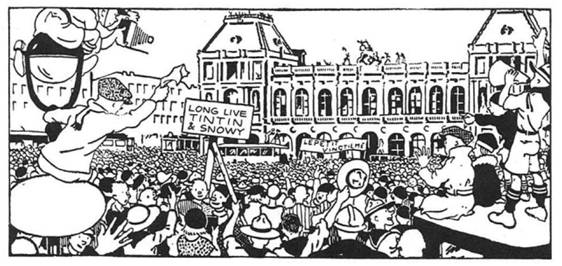
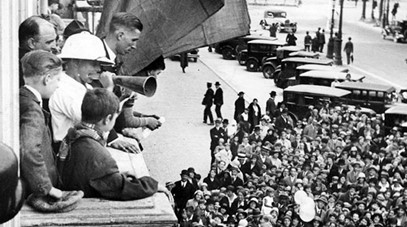
(Source: “Tintin…”)
Another aspect of the growth of Tintin’s significance that cannot be overlooked is the role of WWII. The war saw a shift in Tintin’s original character and stories. When Germany invaded Belgium in May 1940 and Le Vingtième Siècle was closed, Herge began writing Tintin stories for Le Soir, Belgium’s biggest newspaper that had been taken over by the Germans. Herge was criticized for appearing to sympathize with the Germans, but he considered himself to be neutral throughout the war and “applied [that] to the stories he wrote for Le Soir, eschewing criticism of real-world events in favor, not of a return to Belgian patriotism, but of fantastic, larger-than-life adventures replete with elements taken from fantasy or science-fiction, with a small degree of ‘defense of the weak’ sprinkled in” (Desbiens-Brassard 36).
However, even with the change from the early volumes where Tintin exemplified Belgian values to the war-time stories that were more general and imaginative, “the sales and popularity of Tintin books were higher during the war than they ever were before. In the eyes of many, Herge had succeeded in boosting the morale of his fellow Belgians during the occupation” (Desbiens-Brassard 36). The Tintin stories published during the war particularly served to bring people to a different universe and provide them with an escape from their reality to a better world. The defense of the weak against more powerful enemies was a theme within the comics that continued after the war, turning Tintin into “‘a valiant force of goodness, crusading against villains whom we still know only too well: warlike dictators, drug smugglers, gun runners, people traffickers, corrupt politicians, criminal businessman’” (Desbiens-Brassard 36). When this new understanding of Tintin emerged, it allowed him to become truly iconic, in Belgium but also around the world.
In addition to The Adventures of Tintin’s prominence and impact on culture, it is also significant in the political realm. For this, it is important to understand that “the political realm is a collective affair in which people temporarily come together to pursue their interests” (Rosch 227). People do not have to share interests or agree, but agonism, which “is a speech-act process of gradually aligning interests in order to formulate a common good and to live in peace together,” can take place and is encouraged (Rosch 227).
These political conversations and the comic’s role in them are vital considerations and incredibly relevant for The Adventures of Tintin, in part due to Tintin’s popularity. Popular culture “helps perpetuate world views and/or delegitimize others. Tintin’s popularity, therefore, suggests that he is a powerful agent in establishing realities, especially when we consider that comics are a major source of children’s political socialization” (Rosch 225). This legitimization of world views can be seen in Tintin in the Land of the Soviets with its anti-communist elements, such as the commentary on stolen wealth, the acknowledgment of the Soviet use of propaganda, and the suggestion of Soviet incompetence since they aren’t able to capture Tintin, to name a few. Tintin’s stories frequently feature his travels and therefore expose readers to new places and ideas, whether cultural, political, or otherwise. “Comics help ‘to craft and restore certain perspectives for each new generation of young minds during the crucial years when children are ‘acquiring the ability to understand stories,’’ [so] reading [Tintin’s Adventures] enables children, adolescents and adults to gain a feeling for, and an understanding of, the elements of the political…” (Rosch 234). Though Tintin isn’t overtly political, his stories introduce thought provoking ideas about the political realm that can be absorbed by audiences of all ages.
Works Cited
Cascone, Sarah. “The Original Drawing for the First-Ever Cover of Tintin, the Beloved Belgian Comic, Could Fetch More than $1.3 Million at Auction.” Artnet News, Artnet News , 30 May 2019, https://news.artnet.com/market/first-tintin-cover-auction-1560115.
Farshore. “The Adventures of Tintin – Tintin in the Land of the Soviets (the Adventures of Tintin).” Farshore, 3 Oct. 2022, https://www.farshore.co.uk/products/tintin-in-the-land-of-the-soviets-the-adventures-of-tintin-Hergé-9781405266512/.
Desbiens-Brassard, Alexandre. “Secret Origins: The Birth of Superman and Tintin as National Icons.” Adapting Superman: Essays on the Transmedia Man of Steel, edited by John Darowski, McFarland & Company, 2021, pp. 27-40.
Douillet, Joseph M. Moscou Sans Voiles: (Neuf Ans de Travail Au Pays Des Soviets). Spes, 1938.
Hergé, et al. The Adventures of Tintin, Reporter for “Le Petit Vingtième,” in the Land of the Soviets. Egmont, 2011.
“Hergé.” Tintin, https://www.tintin.com/en/Hergé#.
Ray, Michael. “Tintin.” Encyclopædia Britannica, Encyclopædia Britannica, Inc., https://www.britannica.com/topic/Tintin.
Rosch, Felix. “’Hooray! Hooray! The End of the World has been Postponed!’ Politics of Peace in the Adventures of Tintin?” Politics, vol. 34, no. 3, 2014, pp. 225-236.
Saint-Ogan, Alain. Zig et Puce. Futuropolis, 1986.
“Statue of Tintin and Snowy.” Visit Brussels, http://www.visit.brussels/en/visitors/venue-details.Statue-of-Tintin-and-Snowy.265683.
“Tintin the hero.” Tintin.com, 8 March 2009, https://www.tintin.com/en/news/3694/tintin-the-hero#.
